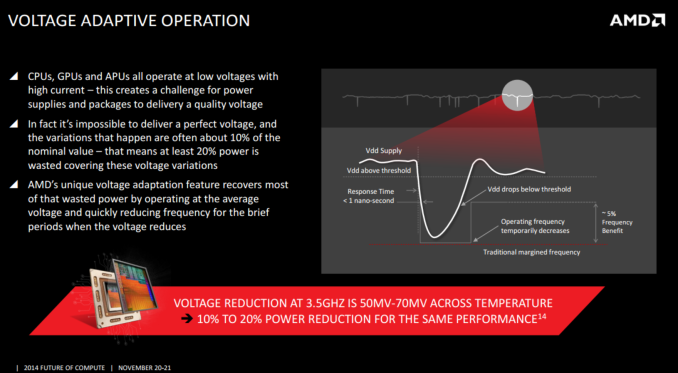AMD Launches Carrizo: The Laptop Leap of Efficiency and Architecture Updates
by Ian Cutress on June 2, 2015 9:00 PM ESTPower Saving and Power Consumption
When it comes to power, Carrizo features two/three technologies worth discussing. The first is the use of low power states, and the different frequency domains within the SoC. Previous designs had relatively few power planes, which left not as many chances for the SoC to power down areas not in use. Carrizo has ten power planes that can be controlled at run-time, allowing for what can be described as a dynamic race to sleep. This is bundled with access to the S0i3 power state, giving sub 50mW SoC power draw when in sleep and wake-up times under a second.
This is also combined with automated voltage/frequency sensors, of which an Excavator core has 10 each. These sensors take into consideration the instructions being processed, the temperature of the SoC, the quality of power delivery as well as the voltage and frequency at that point in order to relay information about how the system should adjust for the optimal power or performance point.
AMD states that this gives them the ability to adjust the frequency/power curve on a per-module basis further again to the right, providing another reduction in power or increase in frequency as required.
Next up for discussion is the voltage adaptive operation that was introduced back in Kaveri. I want to mention it here again because when it was first announced, I thought I understood it at a sufficient level in order to write about it. Well, having crossed another explanation of the feature by David Kanter, the reason for doing so clicked. I’m not going to steal his thunder, but I suggest you read his coverage to find out in more detail, but the concept is this:
When a processor does work, it draws power. The system has to be in a position to provide that power, and the system acts to restabilize the power while the processor is performing work. The work being done will cause the voltage across the processor to drop, to what we classically call Voltage Droop. As long as the droop does not cause the system to go below the minimum voltage required for operation, all is good. Voltage Droop works if the supply of power is consistent, although that cannot always be guaranteed – the CPU manufacturer does not have control over the quality of the motherboard, the power supply or the power conversion at hand. This causes a ripple in the quality of the power, and the CPU has to be able to cope with these ripples as these ripples, combined with a processor doing work, could cause the voltage to drop below the threshold.
The easiest way to cope is to put the voltage of the processor naturally higher, so it can withstand a bigger drop. This doesn’t work well in mobile, as more voltage results in a bigger power draw and a worse experience. There are other potential solutions which Kanter outlines in his piece.
AMD has tackled the problem is to get the processor to respond directly. When the voltage drops below a threshold value, the system will reduce the frequency and the voltage of the processor by around 5%, causing the work being done to slow down and not drain as much. At AMD’s Tech Day, they said this happens in as quickly as 3 cycles from detection, or in under a nanosecond. When the voltage drop is normalized (i.e. the power delivery is a more tolerable level), the frequency is cranked back up and work can continue at a normal rate.
Obviously the level of the threshold and the frequency drop will determine how much time is spent in this lower frequency state. We were told that with the settings used in Carrizo, the CPU hits this state less than 1% of the time, but it accounts for a sizeable chunk of overall average power reduction for a 3.5 GHz processor. This may sound odd, but it can make sense when you consider that the top 5% of the frequency is actually the most costly in terms of power than any other 5%. By removing that 5% extreme power draw, for a minimal performance loss (5% frequency loss for sub 1% of the time), it saves enough power to be worthwhile.













137 Comments
View All Comments
FlushedBubblyJock - Tuesday, June 9, 2015 - link
amazing how a critically correct comment turns into an angry ranting conspiracy from youBillyONeal - Wednesday, June 3, 2015 - link
This is a preview piece. They don't have empirical data because the hardware isn't in actual devices yet. Look at any of AT's IDF coverage and you'll see basically the exact same thing.Refuge - Wednesday, June 3, 2015 - link
nothing has been released yet. but it was announced. This is a news site, you think they are just going to ignore AMD's product announcement? That would be considered "Not doing their job"They go through the claims, explain them, try to see if they are plausible with what little information they have. I like these articles, it gives me something to digest while I wait for a in depth review, and when I go to read said review I know exactly what information I'm most interested in.
KaarlisK - Wednesday, June 3, 2015 - link
About adaptive clocking.Power is not saved by reducing frequency by 5% for 1% of the time.
Power is saved by reducing the voltage margin (increasing frequency at the same voltage) _all_ the time.
Also, when the voltage instability occurs, only frequency is reduced. The requested voltage, IMHO, does not change.
ingwe - Wednesday, June 3, 2015 - link
Interesting. That makes more sense for sure.name99 - Monday, June 8, 2015 - link
It seems like a variant of this should be widely applicable (especially if AMD have patents on exactly what they do). What I have in mind is that when you detect droop rather than dynamically change the frequency (which is hard and requires at least some cycles) you simply freeze the entire chip's clock at the central distribution point --- for one cycle you just hold everything at zero rather than transitioning to one and back. This will give the capacitors time to recover from the droop (and obviously the principle can be extended to freeze the clock for two cycles or even more if that's how long it takes for the capacitors to recover).This seems like it should allow you to run pretty damn close to the minimum necessary voltage --- basically all you now need is enough margin to ensure that you don't overdraw within a worst case single-cycle. But you don't need to provision for 3+ worst-case cycles, and you don't need the alternative of fancy check-point and recovery mechanisms.
KaarlisK - Wednesday, June 3, 2015 - link
About that power plane."In yet more effort to suction power out of the system, the GPU will have its own dedicated voltage plane as part of the system, rather than a separate voltage island requiring its own power delivery mechanism as before"
As I understand it, "before" = same power plane/island as other parts of the SoC.
Gadgety - Wednesday, June 3, 2015 - link
Great read and analysis given the fact that actual units are not available for testing.As a consumer looking for use of Carrizo beyond laptops, provided AMD releases it for consumers, it could be a nice living room HTPC/light gaming unit.
Laxaa - Wednesday, June 3, 2015 - link
I would buy a Dell XPS13-esque machine with this(i.e. high quality materials, good design and a high res screen)Will Robinson - Wednesday, June 3, 2015 - link
According to ShintelDK and Chizow...the above article results are from an Intel chip and AT have been paid to lie and say its Carrizo because their lives would have no meaning if it is a good product from AMD.